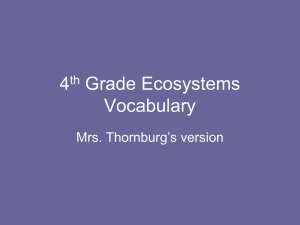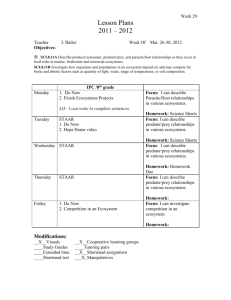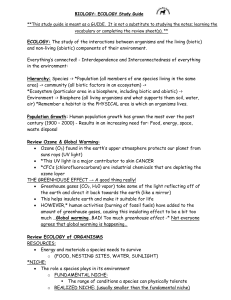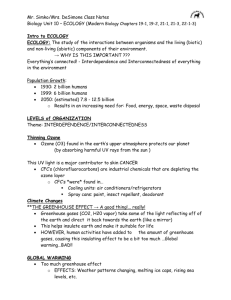The 7 Commandments of an Ecosystem
advertisement
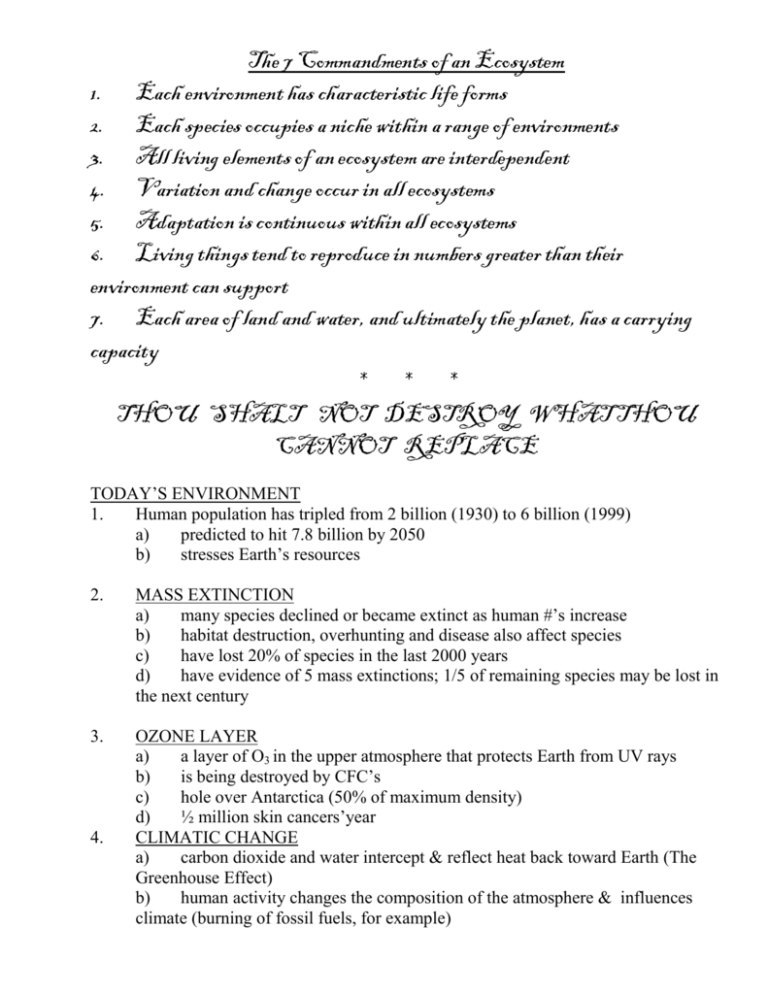
The 7 Commandments of an Ecosystem 1. Each environment has characteristic life forms 2. Each species occupies a niche within a range of environments 3. All living elements of an ecosystem are interdependent 4. Variation and change occur in all ecosystems 5. Adaptation is continuous within all ecosystems 6. Living things tend to reproduce in numbers greater than their environment can support 7. Each area of land and water, and ultimately the planet, has a carrying capacity * * * THOU SHALT NOT DESTROY WHAT THOU CANNOT REPLACE TODAY’S ENVIRONMENT 1. Human population has tripled from 2 billion (1930) to 6 billion (1999) a) predicted to hit 7.8 billion by 2050 b) stresses Earth’s resources 2. MASS EXTINCTION a) many species declined or became extinct as human #’s increase b) habitat destruction, overhunting and disease also affect species c) have lost 20% of species in the last 2000 years d) have evidence of 5 mass extinctions; 1/5 of remaining species may be lost in the next century 3. OZONE LAYER a) a layer of O3 in the upper atmosphere that protects Earth from UV rays b) is being destroyed by CFC’s c) hole over Antarctica (50% of maximum density) d) ½ million skin cancers’year CLIMATIC CHANGE a) carbon dioxide and water intercept & reflect heat back toward Earth (The Greenhouse Effect) b) human activity changes the composition of the atmosphere & influences climate (burning of fossil fuels, for example) 4. c) average global temperature has risen 1 degree since 1860; 3-8 degrees more predicted by 2100 d) would change weather patterns, rising sea levels 5. BIOSPHEREBIOMEECOSYSTEMCOMMUNITY POPULATIONORGANISM (Levels of organization) A) BIOSPHERE --the portion of the earth & atmosphere that supports life --extends from 5-6 miles above the earth’s surface to the deepest part of the oceans (~13 miles) B) BIOME --a complex of ecosystems characterized by distinct vegetation types, determined by climate C) COMMUNITY—all the populations of organisms in a specific ecosystem D) Population—all the organisms of a species in one place ECOSYSTEM INTERACTIONS I. Abiotic factors A. Temporary 1. clouds cover the sun 2. loss of turgor in plant cells B. II. Permanent 1. volcanic eruption 2. continental drift Biotic factors A. Food chain—transfer of energy from one trophic level to another 1. sunlight is the source of all energy (but not biotic) 2. producers obtain energy directly from the sun to make their own “food” 3. primary consumers (herbivores) eat the producers a. secondary consumers eat the herbivores (carnivores) b. a top predator (tertiary consumer) may be present 4. Other a. Scavengers (aka detritivores) feed on dead organisms b. decomposers feed on/break down tissues and wastes of other organisms (bacteria, fungi) B. C. Food webs 1. are more complex and realistic Resources—substances required for life, growth & reproduction III. Ecosystem changes (natural) A. Succession: regular progression of species replacement 1. primary succession—occurs where nothing has ever grown before (bare rock) 2. Secondary succession—occurs where previous growth has occurred 3. end result is a climax community IV. Energy Losses within Ecosystems A. Biomass—dry weight of tissue and other organic matter 1. primary productivity—amount of organic matter produced by photosynthetic plants a. decreases, as energy transfer is inefficient COMMUNITY ECOLOGY SPECIES INTERACTIONS 1. Predation: a predator captures, kills & consumes another individual (prey) a. adaptations that improve efficiency in hunting are favored by natural selection in the predator species b. adaptations that improve escaping/avoidance in prey species are favored by natural selection 2. Mimicry is an anti-predator defense a. coral snake vs. king snake b. Bees vs. wasps 3. Plant-Herbivore interactions a. a form of predation b. some plants have formed defenses through natural selection (thorns, spines, secondary compounds, ie, poison ivy) 4. Parasitism (resembles predation, but is passive-aggressive ) a. one organism benefits (parasite) b. one organism may be harmed (host) c. ectoparasites prey on the outside of the host (ticks, leeches) d. endoparasites prey on the inside of the host (tapeworm, fluke) e. may have a strong negative impact on the host; has caused the evolution of strong defenses in host species (skin, chemicals, immune system cells) f. parasites evolve as well (tapeworm, for example) 5. Competition—2 or more species compete for the same resources a. may result in competitive exclusion (one species eliminated) (see p. 401, barnacles) b. competition has the capacity to influence the community 1) natural selection favors differences in competing species (character displacement)—think of Darwin’s finches c. resource partitioning reduced (fundamental niche vs. realized niche) 6. Mutualism—cooperative relationship which benefits both species a. ants & acacia—ants nest in the shrub and are protected by the thorns; ants in turn help protect shrub from predators and trim back shady areas 7. Commensalism—one benefits, one is unaffected a. humans and E. coli b. remora (fish) and shark


